Experimental Performance Evaluation of an Integrated, LCPV/T Membrane Distillation System for Electricity and Seawater Desalination
Abstract
1. Introduction
2. Experimental Methods
2.1. Overall System Setup
2.2. VMD Subsystem
2.3. Mathematical Model and Evaluation Method
2.3.1. Mass Transfer Flux in VMD
2.3.2. The Heat Transfer Model in VMD
2.3.3. Water Yield Rate and Desalination Rate
2.3.4. Thermoelectric Properties and Exergy Efficiency
2.3.5. Economic Evaluation
3. Results and Discussion
3.1. System Performance Analysis
3.1.1. Single VMD Process
3.1.2. Two-Stage Heating in LCPV/T
3.1.3. Membrane Water Flux in VMD
3.1.4. Thermoelectric Efficiency and Exergy Efficiency
3.2. Seasonal System Performance
3.2.1. Seasonal Irradiation
3.2.2. Seasonal Outlet Heating Temperature of LCPV/T
3.2.3. Seasonal Membrane Flux
3.2.4. Analysis of MF and the Membrane Temperature Difference
3.2.5. Seasonal Thermoelectric Performance
3.3. Membrane Desalination Performance
3.4. Power Generation Performance and Economy Analysis
4. Conclusions
- (1)
- The average outlet temperature of LCPV/T modules by two-stage heating can be maintained above 65 °C in summer, with a maximum of 71.4 °C, which is beneficial for water desalination. The outlet water in summer and autumn can ensure the VMD process. However, it is necessary to open the auxiliary device to heat the outlet water in winter.
- (2)
- In the summer tap water experiment, the maximum membrane flux of the membrane module is 2.73 kg/(m2·h) The desalination rate of the VMD module to the simulated seawater (25 g/L) can reach 99.94%, and the membrane flux of simulated seawater reaches 3.11 kg/(m2·h), which indicates that the membrane module can well realize seawater desalination treatment.
- (3)
- The natural membrane flux was significantly affected by the season; the highest in summer was 1.71 kg/(m2·h). To realize the effective operation of the membrane distillation module in autumn and winter, auxiliary heating is needed in autumn and winter. The autumn membrane flux by auxiliary heating is better than that in winter, and the highest value is 1.85 kg/(m2·h), which is higher than the average natural membrane flux in summer.
- (4)
- Compared to the different seasons, the average electrical efficiency of the system in winter is better than that in summer and autumn, while the average thermal efficiency and average total exergy efficiency in summer are higher than those in autumn and winter, and the maximum average exergy efficiency is 11.29%. Under sunny conditions, the average daily composite incomes of the system in different seasons are all positive, and the highest in summer is 11.67 CNY/day, indicating that the system has certain application prospects.
Author Contributions
Funding
Conflicts of Interest
Nomenclature
| Abbreviations | |
| AGMD | air gap membrane distillation |
| ADCI | average daily composite income |
| CPVC | chlorinated polyvinyl chloride |
| DCMD | direct contact membrane distillation |
| LCPV/T | low concentrated photovoltaic/thermal |
| MD | membrane distillation |
| MF | membrane flux |
| PTFE | polytetrafluoroethylene |
| PV | photovoltaic |
| SGMD | sweeping gas membrane distillation |
| VMD | vacuum membrane distillation |
| Symbols | |
| Am | effective membrane area, m2 |
| APV | PV panel area, m2 |
| Ac | LCPV/T module total area, m2 |
| B | membrane permeability, mol/(m2s·Pa) |
| C | geometric concentration ratio |
| cp | specific heat capacity of cooling liquid, J/(kg·°C) |
| cf | feed side concentration, g/L |
| cd | permeate side concentration, g/L |
| Ee | electrical exergy, J |
| Eth | thermal exergy, J |
| G | solar irradiation, W/m2 |
| evaporation enthalpy of the permeating component, J/mol | |
| hf | heat transfer coefficient of feed liquid side, W/(m2·K) |
| J | membrane permeation flux, kg/(m2·h) |
| water yield, kg | |
| mass flow of cooling liquid, kg/h | |
| pressure difference between the membrane sides, Pa | |
| Qf | heat flux of the feed liquid side, W/m2 |
| Qv | heat flux of vaporization, W/m2 |
| r | reflectivity of LCPV/T module |
| Tb,f | main bulk temperature of the feed liquid side, °C |
| inlet temperature of LCPV/T channels, °C | |
| outlet temperature of LCPV/T channels, °C | |
| Tm,f | membrane surface temperature on the feed liquid side, °C |
| Um | voltage in maximum power point, V |
| Im | current in maximum power point, A |
| Greek Letters | |
| electrical exergy efficiency | |
| thermal exergy efficiency | |
| overall exergy efficiency | |
| solar energy exergy conversion coefficient | |
| desalination rate, % | |
| feed liquid conductivity, μS/cm | |
| permeate water conductivity, μS/cm |
References
- Ruskowitz, J.A.; Suárez, F.; Tyler, S.W.; Childress, A.E. Evaporation suppression and solar energy collection in a salt-gradient solar pond. Sol. Energy 2014, 99, 36–46. [Google Scholar] [CrossRef]
- Joy, N.; Antony, A.; Anderson, A. Experimental study on improving the performance of solar still using air blower. Int. J. Ambient. Energy 2018, 39, 613–616. [Google Scholar] [CrossRef]
- Antonetto, G.; Morciano, M.; Alberghini, M.; Malgaroli, G.; Ciocia, A.; Bergamasco, L.; Spertino, F.; Fasano, M. Synergistic freshwater and electricity production using passive membrane distillation and waste heat recovered from camouflaged photovoltaic modules. J. Clean. Prod. 2021, 318, 128464. [Google Scholar] [CrossRef]
- Liu, Z.; Zhang, H.; Cheng, C.; Huang, J. Energetic performance analysis on a membrane distillation integrated with low concentrating PV/T hybrid system. Renew. Energy 2021, 179, 1815–1825. [Google Scholar] [CrossRef]
- Rahaoui, K.; Ding, L.C.; Tan, L.P.; Mediouri, W.; Mahmoudi, F.; Nakoa, K.; Akbarzadeh, A. Sustainable Membrane Distillation Coupled with Solar Pond. Energy Procedia 2017, 110, 414–419. [Google Scholar] [CrossRef]
- Sayer, A.H.; Al-Hussaini, H.; Campbell, A.N. Experimental analysis of the temperature and concentration profiles in a salinity gradient solar pond with, and without a liquid cover to suppress evaporation. Sol. Energy 2017, 155, 1354–1365. [Google Scholar] [CrossRef]
- Chafidz, A.; Kerme, E.D.; Wazeer, I.; Khalid, Y.; Ajbar, A.; Al-Zahrani, S.M. Design and fabrication of a portable and hybrid solar-powered membrane distillation system. J. Clean. Prod. 2016, 133, 631–647. [Google Scholar] [CrossRef]
- Miladi, R.; Frikha, N.; Gabsi, S. Exergy analysis of a solar-powered vacuum membrane distillation unit using two models. Energy 2016, 120, 872–883. [Google Scholar] [CrossRef]
- Burhan, M.; Shahzad, M.W.; Ybyraiymkul, D.; Oh, S.J.; Ghaffour, N.; Ng, K.C. Performance investigation of MEMSYS vacuum membrane distillation system in single effect and multi-effect mode. Sustain. Energy Technol. Assess. 2019, 34, 9–15. [Google Scholar] [CrossRef]
- Miladi, R.; Frikha, N.; Kheiri, A.; Gabsi, S. Energetic performance analysis of seawater desalination with a solar membrane distillation. Energy Convers. Manag. 2019, 185, 143–154. [Google Scholar] [CrossRef]
- Bait, O. Exergy, environ–economic and economic analyses of a tubular solar water heater assisted solar still. J. Clean. Prod. 2019, 212, 630–646. [Google Scholar] [CrossRef]
- Chen, Q.; Muhammad, B.; Akhtar, F.H.; Ybyraiymkul, D.; Muhammad, W.S.; Li, Y.; Ng, K.C. Thermo-economic analysis and optimization of a vacuum multi-effect membrane distillation system. Desalination 2020, 483, 114413. [Google Scholar] [CrossRef]
- Cui, L.; Zhang, P.; Xiao, Y.; Liang, Y.; Liang, H.; Cheng, Z.; Qu, L. High Rate Production of Clean Water Based on the Combined Photo-Electro-Thermal Effect of Graphene Architecture. Adv. Mater. 2018, 30, 1706805. [Google Scholar] [CrossRef] [PubMed]
- Chen, Q.; Burhan, M.; Akhtar, F.H.; Ybyraiymkul, D.; Shahzad, M.W.; Li, Y.; Ng, K.C. A decentralized water/electricity cogeneration system integrating concentrated photovoltaic/thermal collectors and vacuum multi-effect membrane distillation. Energy 2021, 230, 120852. [Google Scholar] [CrossRef]
- Wang, W.; Shi, Y.; Zhang, C.; Hong, S.; Shi, L.; Chang, J.; Li, R.; Jin, Y.; Ong, C.; Zhuo, S.; et al. Simultaneous production of fresh water and electricity via multistage solar photovoltaic membrane distillation. Nat. Commun. 2019, 10, 3012. [Google Scholar] [CrossRef]
- Elminshawy, N.A.; Gadalla, M.A.; Bassyouni, M.; El-Nahhas, K.; Elminshawy, A.; Elhenawy, Y. A novel concentrated photovoltaic-driven membrane distillation hybrid system for the simultaneous production of electricity and potable water. Renew. Energy 2020, 162, 802–817. [Google Scholar] [CrossRef]
- Zarzoum, K.; Zhani, K.; Bacha, H.B.; Koschikowski, J. Experimental parametric study of membrane distillation unit using solar energy. Sol. Energy 2019, 188, 1274–1282. [Google Scholar] [CrossRef]
- Al-Hrari, M.; Ceylan, İ.; Nakoa, K.; Ergün, A. Concentrated photovoltaic and thermal system application for fresh water production. Appl. Therm. Eng. 2020, 171, 115054. [Google Scholar] [CrossRef]
- Krnac, A.; Araiz, M.; Rana, S.; Velardo, J.; Date, A. Investigation of Direct Contact Membrane Distillation coupling with a Concentrated Photovoltaic solar system. Energy Procedia 2019, 160, 246–252. [Google Scholar] [CrossRef]
- Haiping, C.; Xinxin, G.; Heng, Z.; Yang, L.; Haowen, L.; Yuegang, B. Experimental study on a flash tank integrated with low concentrating PV/T (FT-LCPVT) hybrid system for desalination. Appl. Therm. Eng. 2019, 159, 113874. [Google Scholar] [CrossRef]
- Jantaporn, W.; Ali, A.; Aimar, P. Specific energy requirement of direct contact membrane distillation. Chem. Eng. Res. Des. 2017, 128, 15–26. [Google Scholar] [CrossRef]
- Khayet, M. Membranes and theoretical modeling of membrane distillation: A review. Adv. Colloid Interface Sci. 2010, 164, 56–88. [Google Scholar] [CrossRef] [PubMed]
- Evola, G.; Marletta, L. Exergy and thermoeconomic optimization of a water-cooled glazed hybrid photovoltaic/thermal (PVT) collector. Sol. Energy 2014, 107, 12–25. [Google Scholar] [CrossRef]
- Zhang, H.; Liang, K.; Chen, H.; Gao, D.; Guo, X. Thermal and electrical performance of low-concentrating PV/T and flat-plate PV/T systems: A comparative study. Energy 2019, 177, 66–76. [Google Scholar] [CrossRef]
- Xinxin, G.; Heng, Z.; Haiping, C.; Kai, L.; Jiguang, H.; Haowen, L. Experimental and theoretical investigation on a hybrid LCPV/T solar still system. Desalination 2019, 468, 114063. [Google Scholar] [CrossRef]
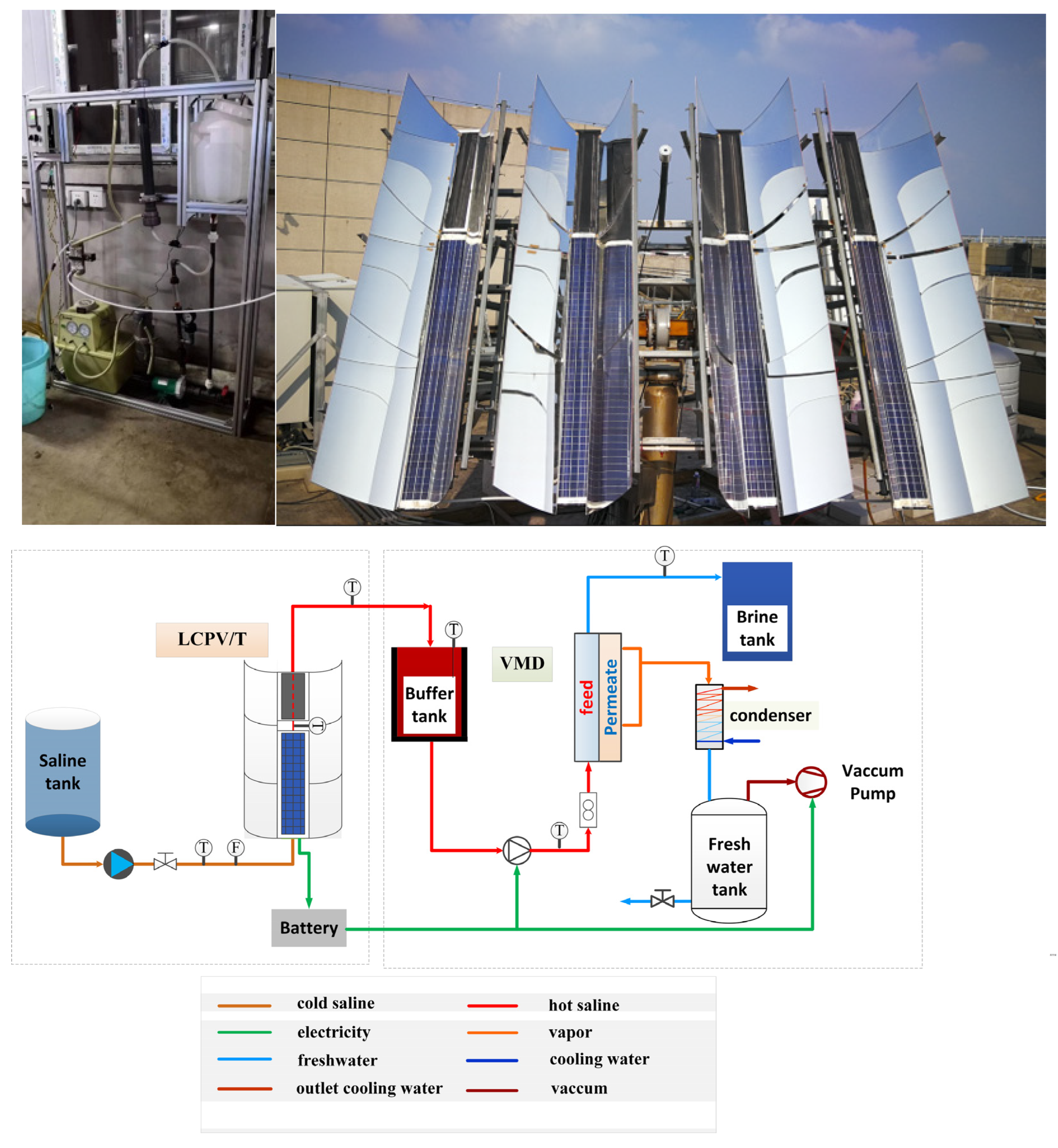
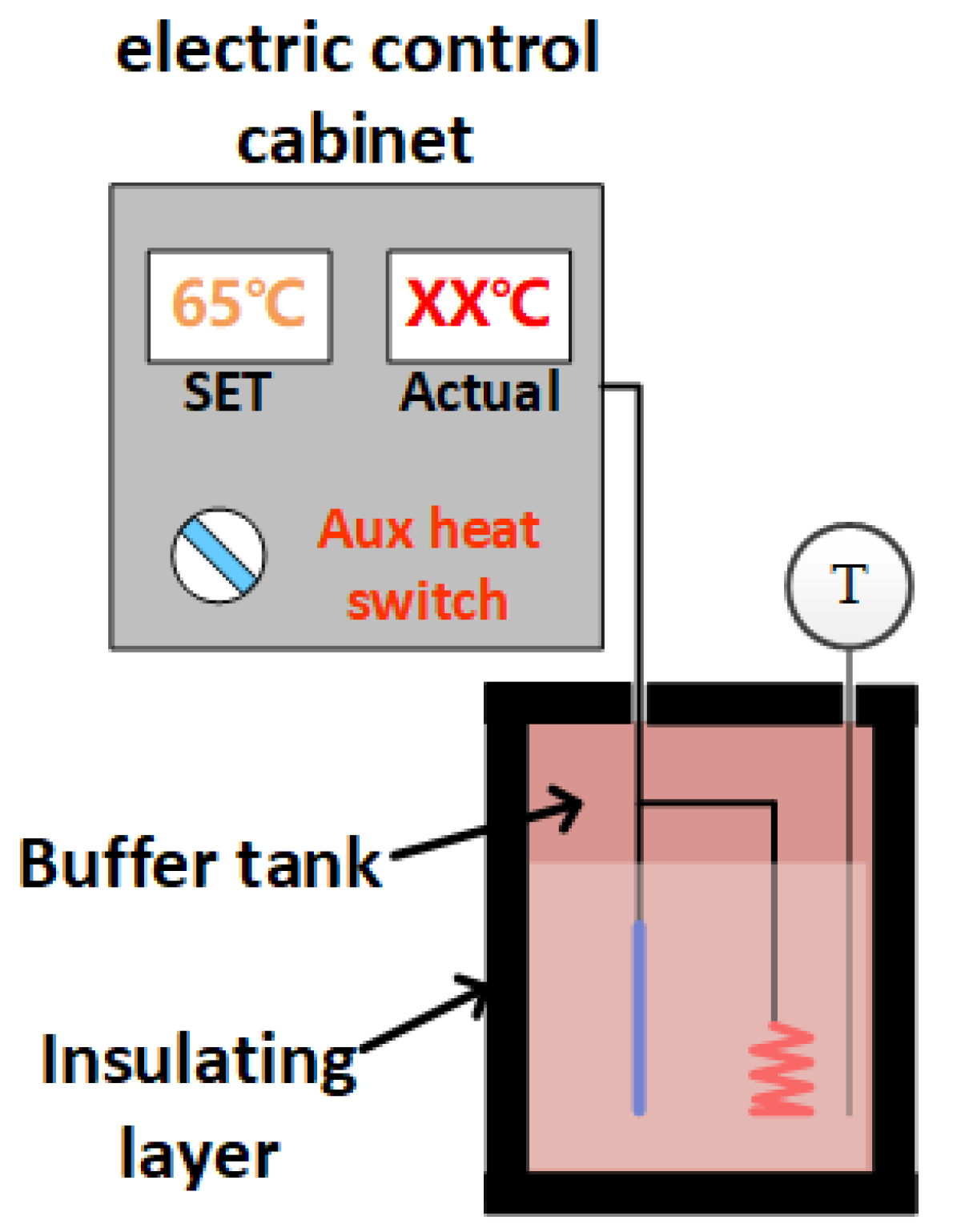
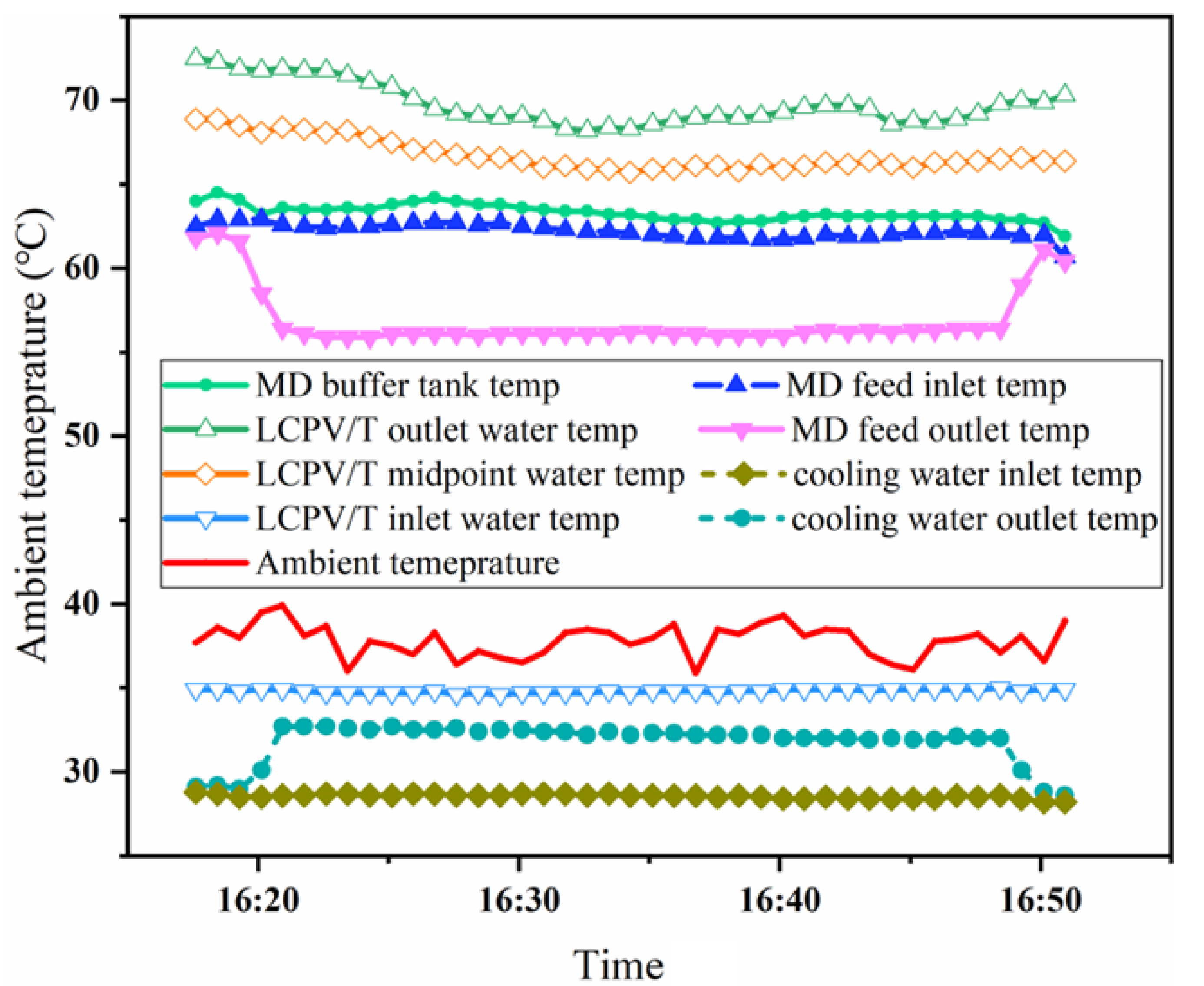
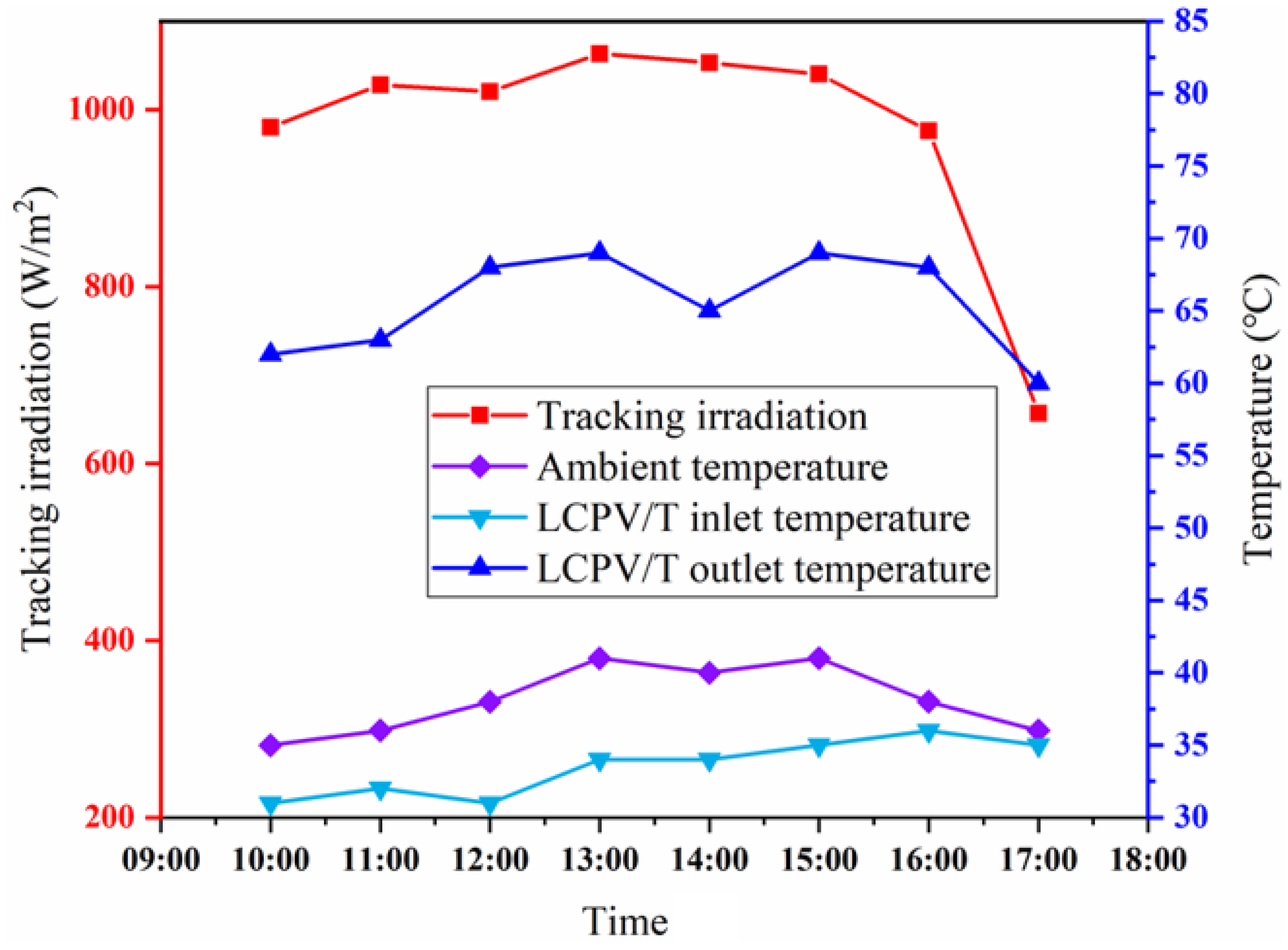
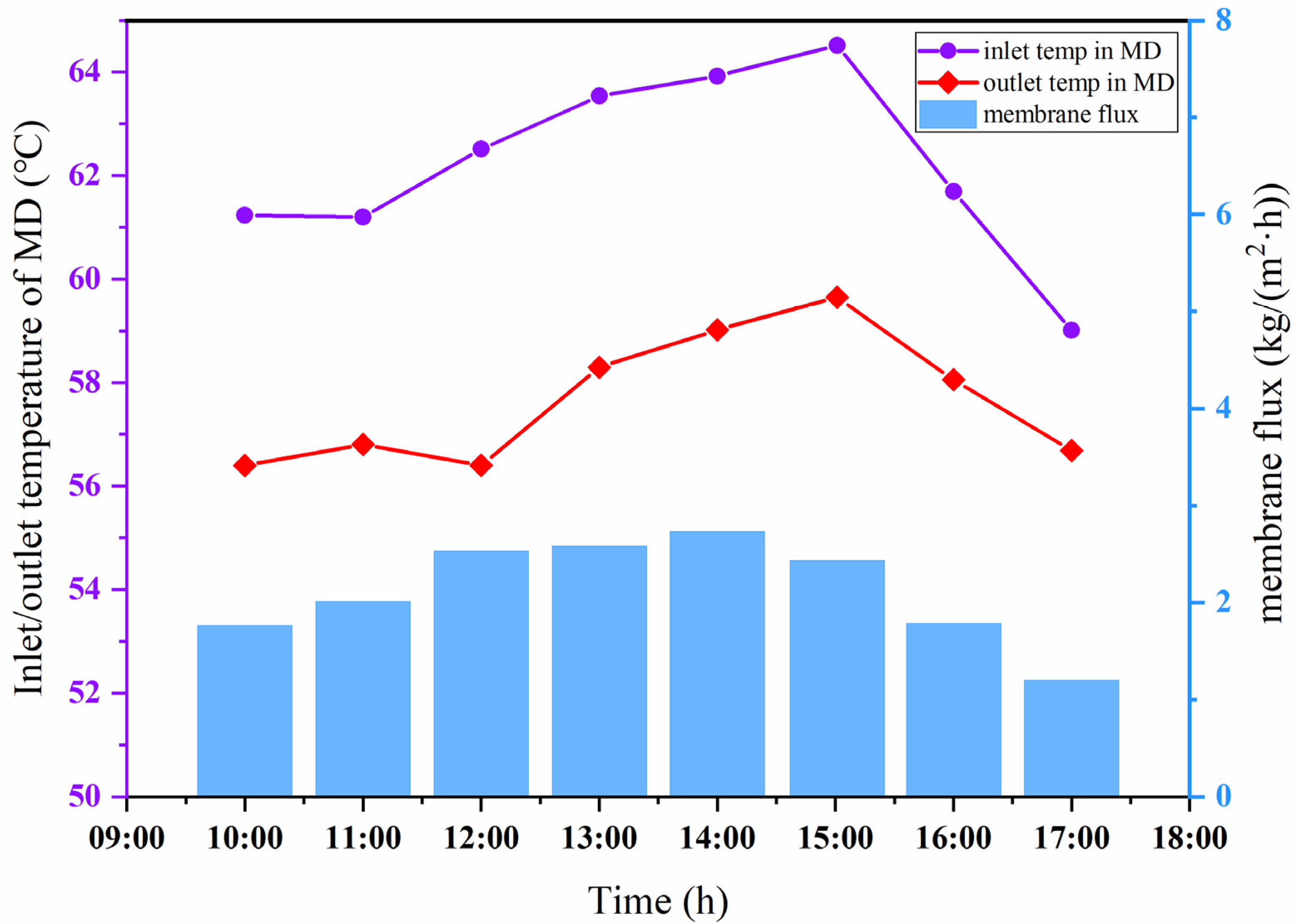


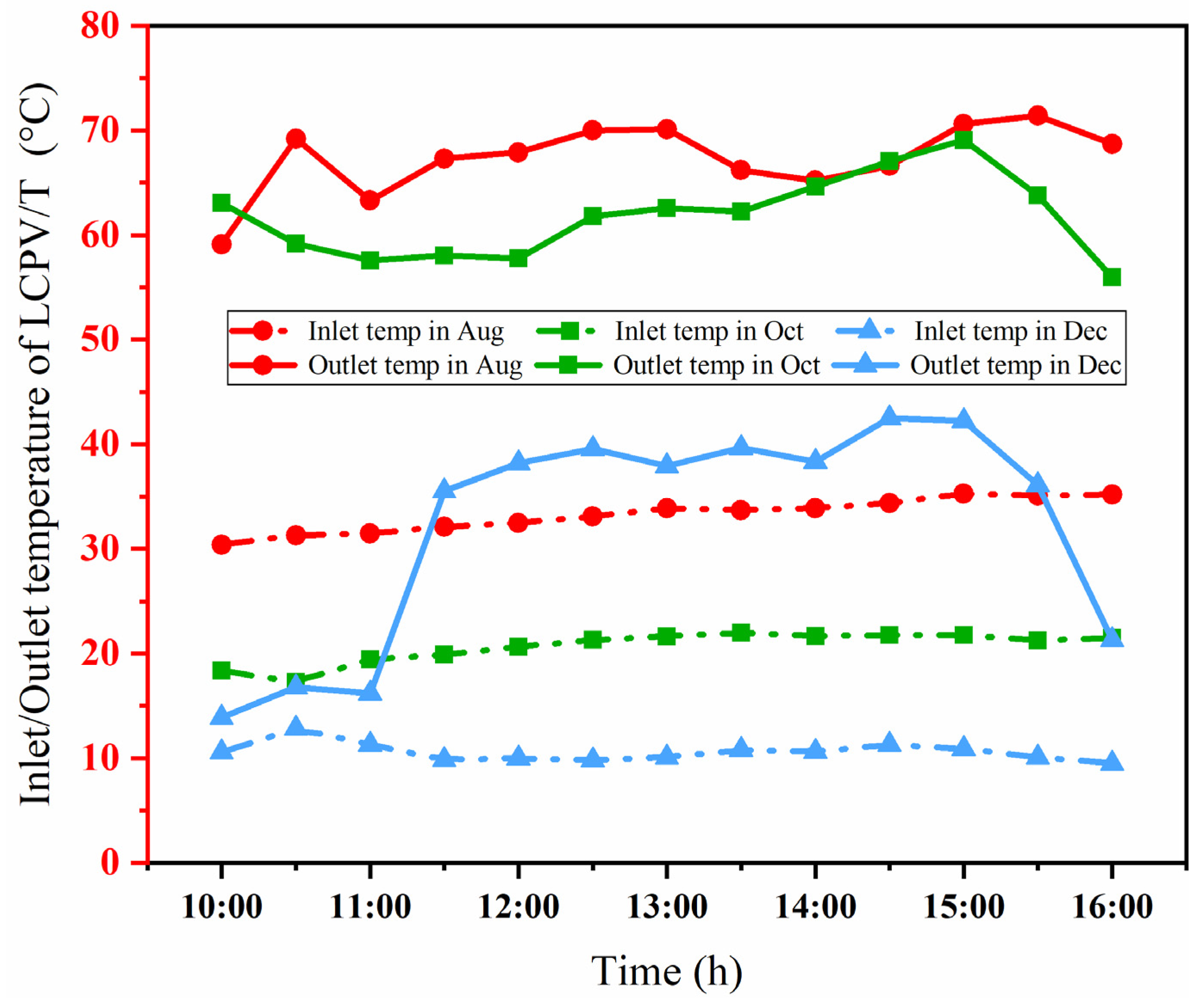
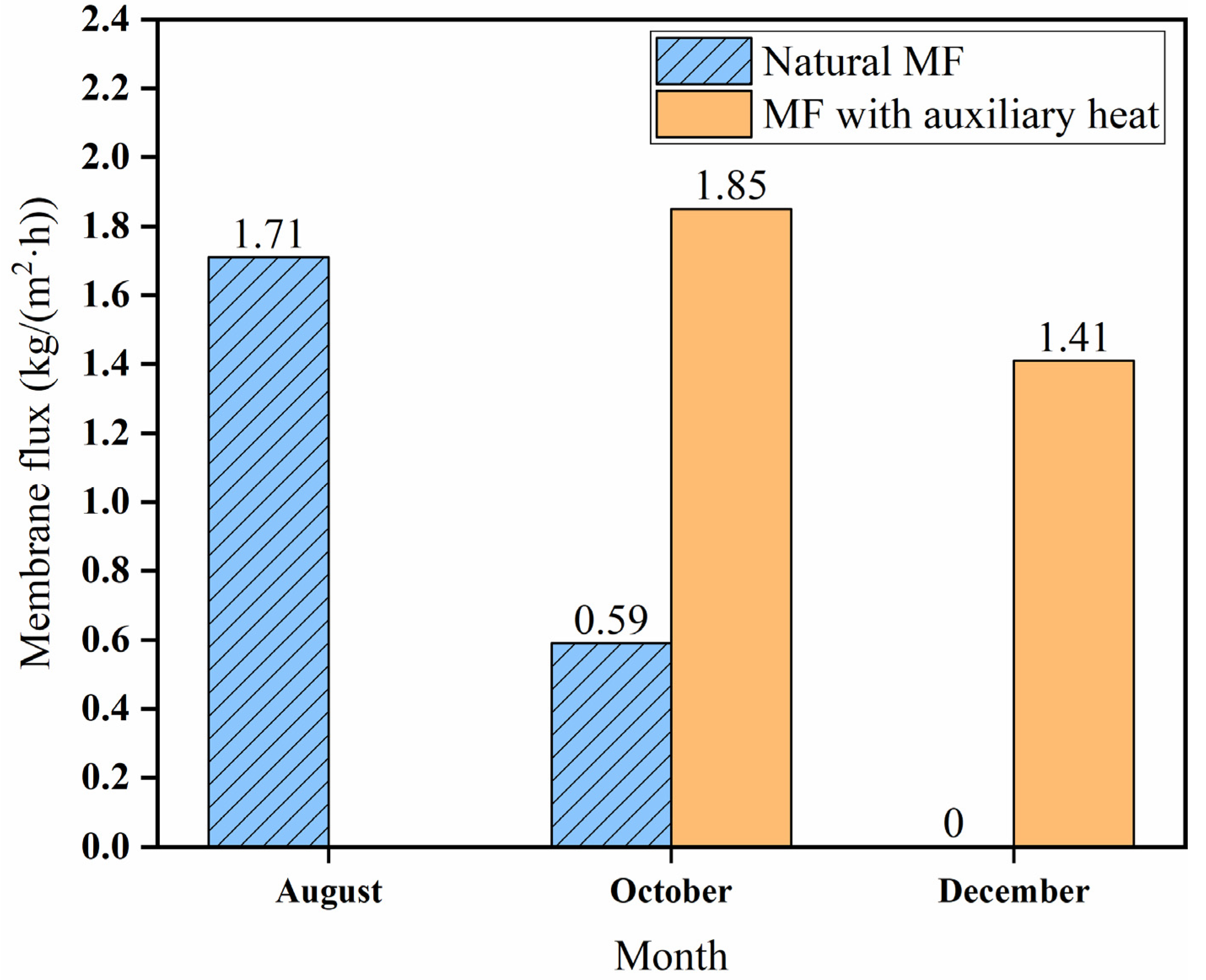
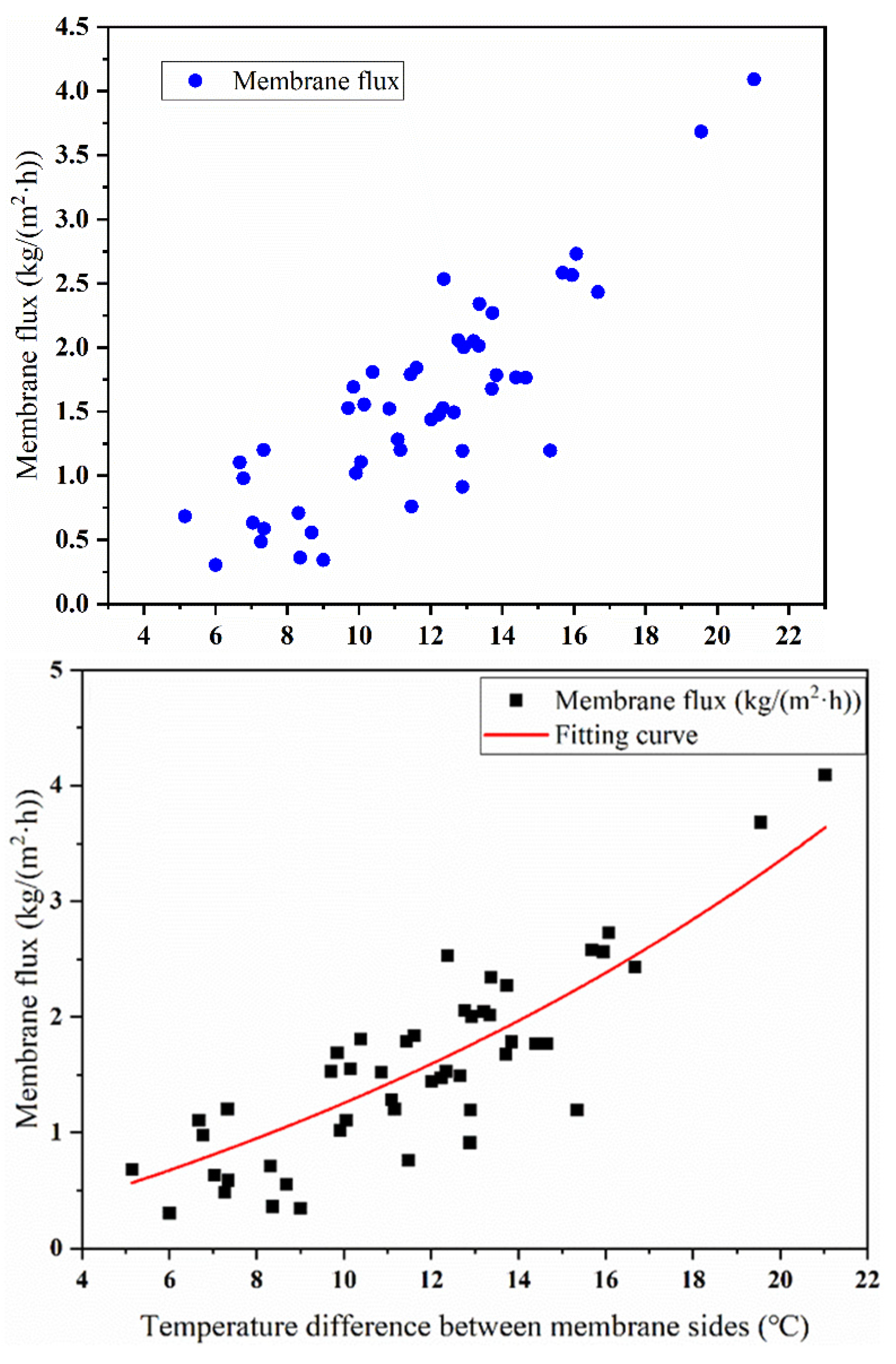
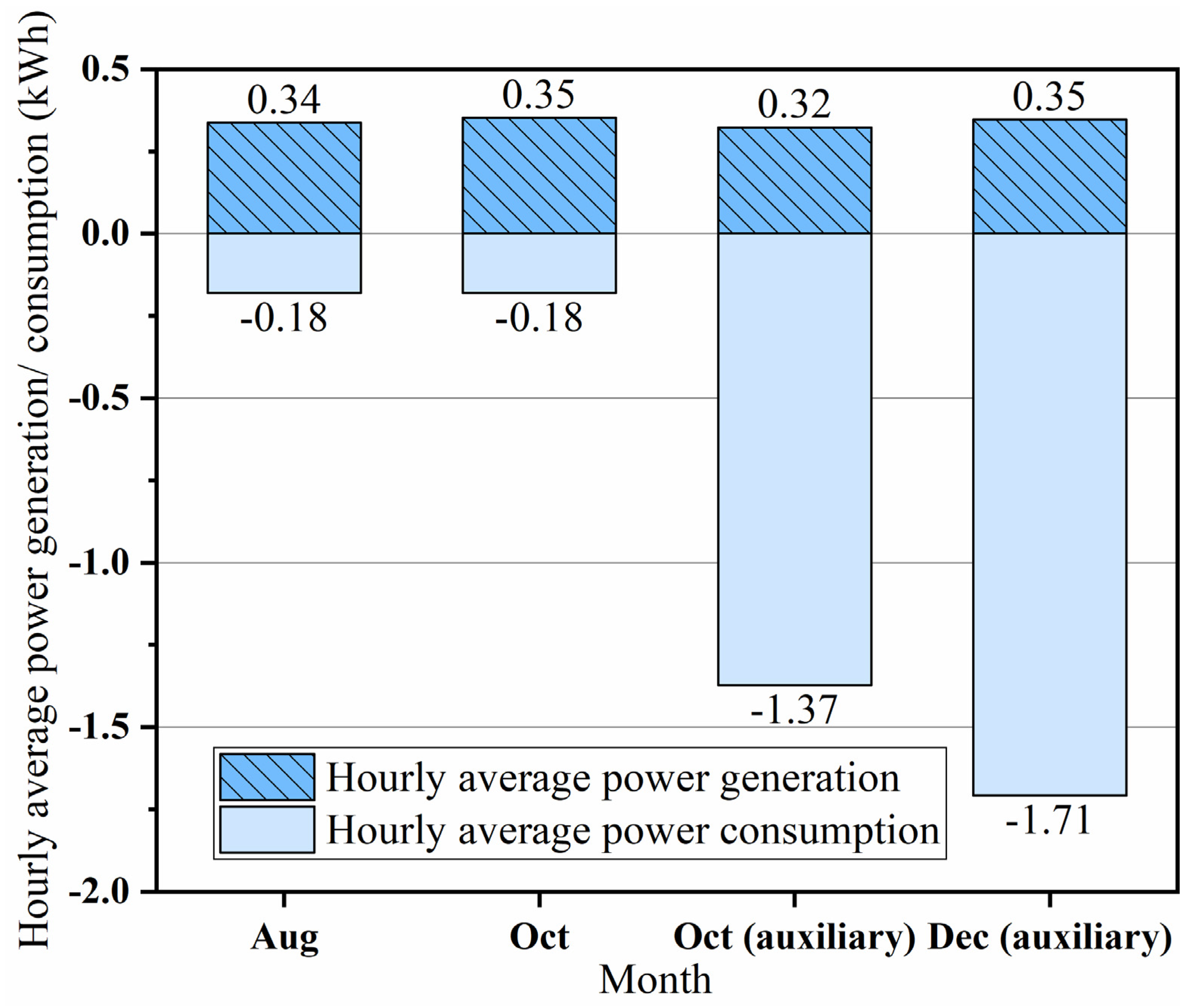
| Month | Electrical Efficiency ηe (%) | Thermal Efficiency ηth (%) | Electrical Exergy Efficiency ζe (%) | Thermal Exergy Efficiency ζth (%) | Total Exergy Efficiency ζo (%) |
|---|---|---|---|---|---|
| August | 9.44 | 55.41 | 10.14 | 4.73 | 11.29 |
| October | 9.99 | 40.55 | 10.73 | 1.75 | 8.69 |
| December | 11.25 | 35.13 | 12.08 | 0.08 | 7.89 |
| Temperature (°C) | Vacuum Degree (MPa) | Desalination Rate (%) |
|---|---|---|
| 50 | 0.09 | 97.33 |
| 55 | 0.09 | 96.71 |
| 60 | 0.09 | 98.22 |
| 65 | 0.09 | 97.85 |
| 70 | 0.09 | 98.83 |
| Month | Operation Hours per Day (h) | Thermal Revenue (USD/h) | Fresh Water Revenue (USD/h) | Electricity Revenue (USD/h) | ADCI (USD) |
|---|---|---|---|---|---|
| August | 8 | 0.0853 | 0.116 | 0.006 | 1.632 |
| October | 7 | 0.078 | 0.041 | 0.007 | 0.877 |
| October (aux) | 7 | 0.078 | 0.125 | −0.078 | 0.878 |
| December (aux) | 6 | 0.06 | 0.095 | −0.099 | 0.336 |
Publisher’s Note: MDPI stays neutral with regard to jurisdictional claims in published maps and institutional affiliations. |
© 2022 by the authors. Licensee MDPI, Basel, Switzerland. This article is an open access article distributed under the terms and conditions of the Creative Commons Attribution (CC BY) license (https://creativecommons.org/licenses/by/4.0/).
Share and Cite
Huang, S.; Liu, Z.; Zhang, Y.; Su, D.; Sun, D.; Cheng, C. Experimental Performance Evaluation of an Integrated, LCPV/T Membrane Distillation System for Electricity and Seawater Desalination. Energies 2022, 15, 9641. https://doi.org/10.3390/en15249641
Huang S, Liu Z, Zhang Y, Su D, Sun D, Cheng C. Experimental Performance Evaluation of an Integrated, LCPV/T Membrane Distillation System for Electricity and Seawater Desalination. Energies. 2022; 15(24):9641. https://doi.org/10.3390/en15249641
Chicago/Turabian StyleHuang, Shengwei, Zhenghao Liu, Yong Zhang, Dan Su, Dongqi Sun, and Chao Cheng. 2022. "Experimental Performance Evaluation of an Integrated, LCPV/T Membrane Distillation System for Electricity and Seawater Desalination" Energies 15, no. 24: 9641. https://doi.org/10.3390/en15249641
APA StyleHuang, S., Liu, Z., Zhang, Y., Su, D., Sun, D., & Cheng, C. (2022). Experimental Performance Evaluation of an Integrated, LCPV/T Membrane Distillation System for Electricity and Seawater Desalination. Energies, 15(24), 9641. https://doi.org/10.3390/en15249641








